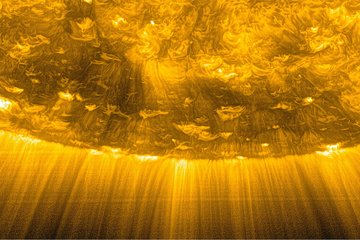All genres
1.
Journal Article
Supersonic Magnetic Upflows in Granular Cells Observed with SUNRISE/IMaX. Astrophysical Journal 723 (2), pp. L144 - L148 (2010)
2.
Journal Article
Spectropolarimetric analysis of 3D MHD sunspot simulations. Astron. Nachrichten 331 (6), pp. 567 - 569 (2010)
3.
Journal Article
Convective Motions and net circular Polarization in Sunspot Renumbrae. Astrophysical Journal 709, pp. 349 - 357 (2010)
4.
Journal Article
Quiet-sun Intensity Contrasts in the Near-ultraviolet as Measured from SUNRISE. Astrophysical Journal 723 (2), pp. L154 - L158 (2010)
5.
Journal Article
Fully resolved quiet Sun magnetic flux tube observed with the Sunrise/IMaX instrument. Astrophysical Journal 723, pp. L164 - L168 (2010)
6.
Journal Article
Models and observations of sunspot penumbrae. Sci. China Ser. G 52 (11), pp. 1670 - 1677 (2009)
7.
Journal Article
Dipolar Evolution in a Coronal Hole Region. Astrophysical Journal 703 (1), pp. 1012 - 1020 (2009)
8.
Journal Article
The structure of sunspot penumbrae - IV. MHS equilibrium for penumbral flux tubes and the origin of dark core penumbral filaments and penumbral grains. Astronomy and Astrophysics 471, pp. 967 - 975 (2007)
9.
Journal Article
On the fine structure of sunspot penumbrae: III. The vertical extension of penumbral filaments. Astronomy and Astrophysics 450, pp. 383 - 393 (2006)
10.
Journal Article
Accurate atomic parameters for near-infrared spectral lines. Astronomy and Astrophysics 404, p. 749 (2003)
11.
Journal Article
Iron abundance in the solar photosphere. Application of a two-component model atmosphere. Astronomy and Astrophysics 391 (3), pp. 331 - 337 (2002)
12.
Journal Article
A two-component model of the solar photosphere from the inversion of spectral lines. Astronomy and Astrophysics 385 (3), pp. 1056 - 1072 (2002)
13.
Conference Paper
Modeling the Fine Structure of a Sunspot Penumbra through the Inversion of Stokes Profiles. Astronomical Society of the Pacific, pp. 235 - 242 (2003)
14.
Conference Paper
Modeling the Fine Structure of a Sunspot Penumbra through the Inversion of Stokes Profiles. In: Current Theoretical Models and Future High Resolution Solar Observations: Preparing for ATST, p. 235 (Eds. Pevtsov, A. A.; Uitenbroek, H.). (2003)











